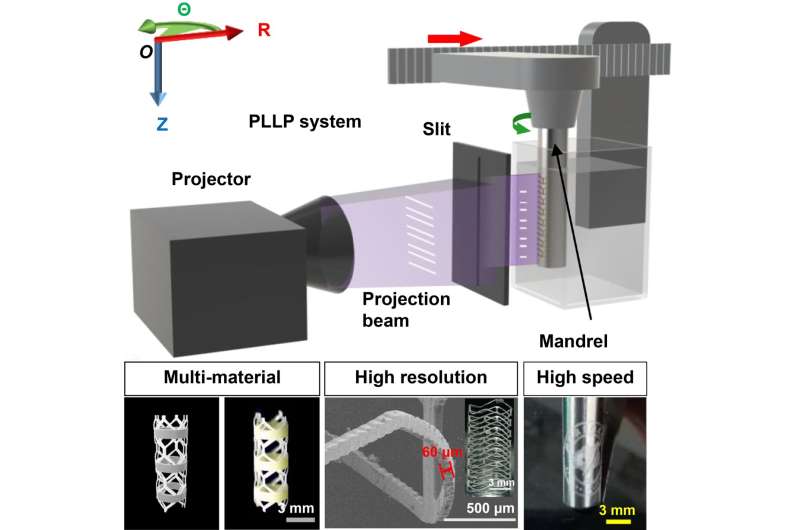

Researchers develop new 3D printing for ultra-thin multi-material tubular struct...
source link: https://techxplore.com/news/2024-04-3d-ultra-thin-multi-material.html
Go to the source link to view the article. You can view the picture content, updated content and better typesetting reading experience. If the link is broken, please click the button below to view the snapshot at that time.

Researchers develop new 3D printing for ultra-thin multi-material tubular structures
by International Journal of Extreme Manufacturing

A novel 3D printing technology developed by Beihang University researchers was able to print multi-material tubular structures with a minimum wall thickness as thin as 50 micrometers and a minimum feature size of 10 micrometers.
The work, reported in the International Journal of Extreme Manufacturing, could someday lead to rapid customization method of tubular grafts and the manufacturing of tubular components in fields such as dentistry, aerospace, and more.
It is challenging to manufacture complex and delicate radially multi-material model geometries without supporting structures, such as tissue vessels and tubular graft, among others.
"Smooth ultra-thin tubular structures are common in biomedical engineering," said Jiebo Li, corresponding author on the paper and Professor in School of Biological Science and Medical Engineering, Beihang University.
"It is difficult to manufacture such structures in the traditional Cartesian coordinate system. To better accommodate tubular structures, why not design the 3D printing platform as a cylinder? By adopting a polar coordinate system, rotation, and retraction steps, the manufacturing of these structures can be easy achieved."
Many advanced 3D printing techniques, with fast printing speed and high precision have been developed in the past several decades. However, none of these techniques are suitable for manufacturing multi-material thin-walled tubular structures.
To achieve varied mechanical properties in multi-material stent printing, researchers utilized Cartesian coordinate-based 3D printing technology, fused deposition modeling (FDM), to manufacture tubular structures. The desired shape is created by printing each layer in x-y plane and stacking different layers in z direction.
Nevertheless, the intraluminal stent usually has a large aspect ratio, with tiny tube diameter and long length, making it difficult to stand on the supporting plate stably.
Based on polar coordinates, the BUAA researchers developed a printing setup with a rotating mandrel as the substrate, called Polar-coordinate Line-projection Light-curing Production (PLLP) technology. The patterned light illumination creates tiny solidified polymeric structures on the rotating mandrel.
The researchers utilized PLLP technology to achieve the fabrication of thin-walled multi-material tubular structures. They validated the advantages of PLLP technology over traditional Cartesian coordinate-based 3D printing methods through simulation and mechanical experiments. Additionally, they confirmed the feasibility of printing hydrogel materials.
"The biggest advantage for PLLP is that one can rapidly fabricate smooth-surfaced tubular multi-material structures," said Professor Li. "This method is particularly beneficial for the swift customization of tubular grafts as well as the manufacturing of tubular components in other fields."
The researchers are continuing the work, hoping to improve the forming speed and resolution. They aim to apply the PLLP technology to a wider range of fields, such as dentistry and aerospace.
More information: Huiyuan Wang et al, Polar-coordinate line-projection light-curing continuous 3D printing for tubular structures, International Journal of Extreme Manufacturing (2024). DOI: 10.1088/2631-7990/ad3c7f
Recommend
About Joyk
Aggregate valuable and interesting links.
Joyk means Joy of geeK